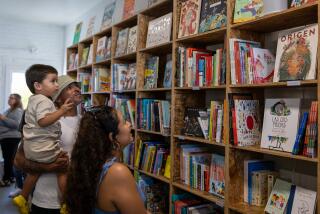Helping Them Tune In With Song, Dance
- Share via
Eliseo Quintero, guitar in hand, greets his pint-size students in bilingual song, chanting to the tune of “Freres Jacques”: “Buenas tardes. Buenas tardes. ¿Como estas? How are you?”
He wants the 3- and 4-year-olds to sing along, but because they’ve had little exposure to English or group singing, they hesitate. They are children of immigrants living in Santa Ana who have little tradition of preschool.
Quintero is one of a dozen or so teachers and volunteers at the Children’s Therapeutic Arts Center, which operates out of a downtown Santa Ana storefront and offers bilingual instruction in art, dance and music to help children better express themselves.
The classes, provided during the day and into early evening, are popular with low-income Latino families whose children might not otherwise be exposed to the arts and especially sought out for children with disabilities and special needs because of their therapeutic value in improving communication skills.
The 4-year-old arts center is operated by a nonprofit organization and funded by grants, private donations and student fees of $5 to $10 per class.
In one class, Quintero helps children learn letters, numbers and songs in Spanish and English. In a few months, his students will be joined by children with cerebral palsy, Down syndrome and autism. Disabled children are already attending other classes at the center, learning keyboard, harp and painting.
“The atmosphere is inspirational,” said Donna Holton Smith, a Santa Ana artist who has volunteered to help in the classes. “It’s unique to combine disabled and normal children. That will help when these children integrate into the world. You can see the kids registering. They are able to keep their attention on what’s going on.”
Center Director Ana Jimenez-Hami believes the nonverbal expression of music and art can not only help those with disabilities for whom verbal communication is difficult but also provide an opportunity for children whose parents live in poverty.
“There are so many problems these families face,” said Jimenez-Hami. “Children can open their hearts through nonverbal vehicles. They can say [through art] what they cannot say [verbally].”
The center, which opened with a small menu of after-school programs, now attracts about 300 families with a range of classes. Additionally, on the first Saturday of each month, the center invites all community children to participate in arts and crafts projects -- such as painting murals and decorating tiles -- outside its classrooms on Broadway.
Among those benefiting from the center’s classes is Elida Diaz, 39, of Santa Ana and her 6-year-old autistic daughter, who was enrolled in the folkloric dance troupe and a choir shortly after the center opened. Struggling at first, the youngster now plays the piano and the harp and knows traditional Mexican dances. Diaz’s autistic son came to the center as a 3-year-old, wanting to strike out at whatever was in front of him, Diaz said.
Fittingly, the center offered him drum classes.
Thanks to such therapy, Diaz said her children were better at paying attention and listening.
Diaz, a stay-at-home mother whose husband earns $7 an hour as a machine operator in a factory, takes her children to classes on a half-hour bus ride, and says it’s worth it.
“If you have children, especially in special education, after-school programs are so important,” she said. “I’ve seen a tremendous change in my children.”
Parents, who gather and talk while children attend classes, are also benefiting from the programs.
“We get ideas from each other and learn how to solve problems,” said Rosalinda Velasco, a 33-year-old mother of two. “If our children are with disabled kids, all the better. They can be teachers to them and learn something themselves.”
Quite often, children and women alike share stories of abuse, Jimenez-Hami said.
When one mother began to explain in a parents meeting how she was sexually abused by her father, four other parents said they were also victims of domestic violence.
“The needs here are so great,” said Jimenez-Hami, who estimates that one-third of the families involved in the center have been affected by some sort of abuse.
“The more we are in the community, the more we learn about the effects of poverty.”
Jimenez-Hami hopes to recruit a social worker to offer group therapy sessions to parents. In the meantime, she is continuing with arts projects.
“This is what heals [children].... They can truly be helped by the arts,” she said.
More to Read
Sign up for Essential California
The most important California stories and recommendations in your inbox every morning.
You may occasionally receive promotional content from the Los Angeles Times.













